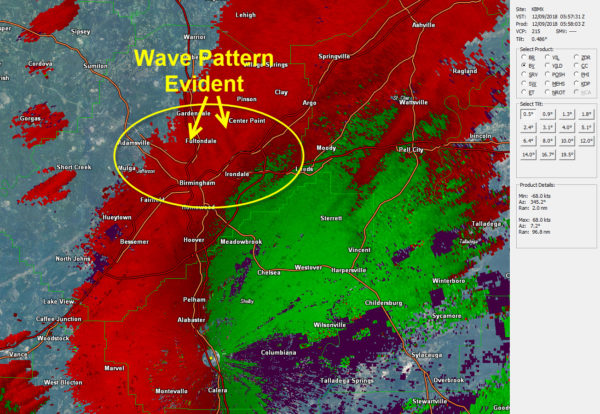A Look at the Saturday, December 8th Wake Low and Gravity Waves that Caused High Winds Across Central Alabama
On Saturday night, December 8th, a high wind event brought strong winds of 30-50 mph to a wide area of Central Alabama. The winds were caused by a wake low that formed in the back of a large mesoscale convective system that moved across the area during the evening hours.
A wake low is a low-pressure system that forms on the back (hence the term “wake”) of an area of rain or thunderstorms. A layer of dry air can try to invade the back side of the precipitation area. As it does, rain falling through the dry air evaporates and cools, causing it to sink. Famed researcher, Dr. Theodore Fujita, discovered the phenomenon in 1963.
This sinking air can acquire a lot of momentum, but sinking air warms as it descends. This sinking, warming air evaporates the rain on the back side of the rain mass, creating a sharp reflectivity gradient.
As the sinking air warms, it becomes buoyant, and eventually starts rising again. This rising air creates lower pressure at the surface and a strong low-pressure area can form. Air rushes in as the atmosphere tries to fill the void. A substantial pressure gradient can be created, and strong winds can be the result as air flows toward the center.
The relationship between wake lows and gravity waves is not completely understood. Gravity waves are like the ripples or waves that form on a pond when you drop in a stone. One thought is that the rapid upward motion caused by the wake low can generate gravity waves that radiate outward from the low. The up and down motion of the waves radiating outward can cause strong winds to be brought easily to the surface.
As the waves move away from the low, a circular wave pattern can be detected in velocity data on Doppler radar. Those waves were evident Saturday night. See the velocity display from BMX at 11:57 p.m. Saturday night, right about the time of the maximum winds at the Birmingham Airport:
In the April 13, 2009 wake low event across Central Alabama, the pressure at Tuscaloosa dropped from 30.03 inches at 11 p.m. to 29.65 inches two hours later. That is an astounding drop in pressure over such a short time. This gradient resulted in widespread damaging winds that downed thousands of trees, many of them on cars and homes. The winds knocked out power to over 150,000 Alabamians. One person died in Atlanta when a tree fell on a house.
In an event on February 22, 1998, the pressure at Birmingham fell 10 millibars in just 17 minutes. This is even more amazing. Winds gusted to 51 mph. There were numerous reports of trees falling on houses and cars. As a result, 20,000 people lost power in the Birmingham area alone. You would have thought that the winds would have been even stronger with the even greater pressure drop, but winds can only rush in so fast.
This past weekend’s event caused the pressure to drop from 30.17 inches just before 9 p.m. to 29.88 inches at 12:35 a.m. As a result, winds gusted to 49 mph at the Birmingham Shuttlesworth International Airport at 11:53 p.m. Winds gusted to over 30 mph for over three hours at BHM. In the opinion of Kevin Laws, the Science and Operations Officer at the National Weather Service Birmingham, the overall windiness was caused by the wake low. The very strong winds between 11 p.m. and midnight were probably the result of the gravity wave feature.
Wake low events are difficult to forecast in advance. As forecasters, we have to look for the tight reflectivity gradient on the back edge of precipitation shields associated with mesoscale convective systems. But often it is surface reports of strong pressure falls and strong winds that signal that an event is underway. Unfortunately, damage reports may start to be received by the time the observations are received.
Wind advisories were issued for Central Alabama at 10:44 p.m. This event underscores why wind advisories and high wind warnings are important and must be heeded. All it takes is a tree on your home or car to cause death or serious injury.
Category: Alabama's Weather, ALL POSTS, Met 101/Weather History

















